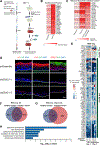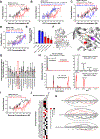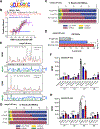Glucose dissociates DDX21 dimers to regulate mRNA splicing and tissue differentiation
- PMID: 36608661
- PMCID: PMC10171372
- DOI: 10.1016/j.cell.2022.12.004
Glucose dissociates DDX21 dimers to regulate mRNA splicing and tissue differentiation
Abstract
Glucose is a universal bioenergy source; however, its role in controlling protein interactions is unappreciated, as are its actions during differentiation-associated intracellular glucose elevation. Azido-glucose click chemistry identified glucose binding to a variety of RNA binding proteins (RBPs), including the DDX21 RNA helicase, which was found to be essential for epidermal differentiation. Glucose bound the ATP-binding domain of DDX21, altering protein conformation, inhibiting helicase activity, and dissociating DDX21 dimers. Glucose elevation during differentiation was associated with DDX21 re-localization from the nucleolus to the nucleoplasm where DDX21 assembled into larger protein complexes containing RNA splicing factors. DDX21 localized to specific SCUGSDGC motif in mRNA introns in a glucose-dependent manner and promoted the splicing of key pro-differentiation genes, including GRHL3, KLF4, OVOL1, and RBPJ. These findings uncover a biochemical mechanism of action for glucose in modulating the dimerization and function of an RNA helicase essential for tissue differentiation.
Keywords: DDX21; RNA helicases; glucose; mRNA splicing; tissue differentiation.
Published by Elsevier Inc.
Conflict of interest statement
Declaration of interests The authors declare no competing interests.
Figures







Comment in
-
Sweet splicing.Cell. 2023 Jan 5;186(1):10-11. doi: 10.1016/j.cell.2022.11.025. Cell. 2023. PMID: 36608648
References
-
- Hay RJ, Johns NE, Williams HC, Bolliger IW, Dellavalle RP, Margolis DJ, Marks R, Naldi L, Weinstock MA, Wulf SK, et al. (2014). The Global Burden of Skin Disease in 2010: An Analysis of the Prevalence and Impact of Skin Conditions. Journal of Investigative Dermatology 134, 1527–1534. 10.1038/jid.2013.446. - DOI - PubMed
Publication types
MeSH terms
Substances
Grants and funding
LinkOut - more resources
Full Text Sources
Miscellaneous

